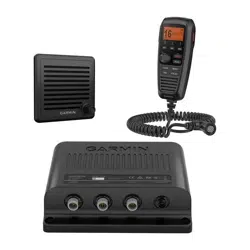Loading ...
Loading ...
Loading ...

Placing All-Ships Calls
All-ships calls are transmitted to all stations within receiving distance of your radio. You can make two types of
all-ships calls. Safety calls broadcast significant navigational or weather-related information. Urgency calls
communicate situations about the safety of a vessel or person when danger is not imminent. The captain
should discern whether a situation warrants a safety call or an urgency call.
1 Select DSC > ALL SHIPS.
2 Select SAFETY or URGENCY.
3 Select a channel (Individual Call or Group Call Channels, page 14).
The radio transmits the channel request with your call.
4 Select CALL.
The radio transmits the call on channel 70, then changes to the selected channel.
Individual Call or Group Call Channels
When placing an individual or group call, you should select from designated DSC channels. The radio transmits
this request with your call.
• USA: channels 6, 8, 9, 10, 13, 17, 67, 68, 69, 71, 72, 73, and 77.
• Canada and International: all USA channels, plus channel 15
DSC channels are limited to channels that are available in all frequency bands. You can select CUSTOM to
select a channel that is not listed. If you select a custom channel, the station you are calling may not be able to
comply with the specified channel. You should select a channel that is appropriate for communication.
Requesting a Vessel's Position
Position data received from stations that respond to position request calls is sent over the NMEA
®
network. You
can track the vessels on your Garmin chartplotter.
1 Select DSC > POS. REQUEST.
2 Select an option:
• To enter the MMSI number manually, select MANUAL, enter the MMSI number, and select ACCEPT.
• To select an entry from the directory, select DIRECTORY, and select an entry.
3 Select CALL.
The radio transmits the call on channel 70 and returns to the previous channel. WAITING FOR
ACKNOWLEDGE appears on the screen.
Receiving Calls
Receiving Distress Calls and Distress Relay Calls
When receiving a distress call or a distress relay call, DISTRESS or DISTR RELAY, and information about the call,
such as MMSI number and the nature of the distress, appear on the radio screen. A distress call is sent from a
vessel in need of assistance, and a distress relay call is sent from either another vessel or a station on behalf of
a vessel in need of assistance.
The radio sends data related to the call over the NMEA network based on how you configure MMSI filters
(Configuring DSC NMEA Transmissions, page 21).
NOTE: When a distress call is received, the radio switches to channel 16 automatically after ten seconds.
When a distress call is received, select an option:
• To view additional information about the distress call and switch to channel 16, select .
• To accept the distress call and switch to channel 16, select OK.
• To review information about the distress call without switching to channel 16 automatically, select
PAUSE.
• To ignore the distress call and stay on the current channel, press CLEAR.
14 Digital Selective Calling
Loading ...
Loading ...
Loading ...
